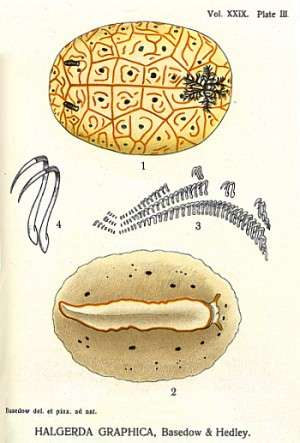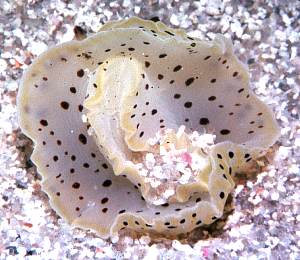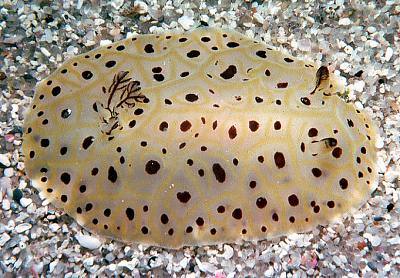
Halgerda graphica
Basedow & Hedley, 1905
Order: NUDIBRANCHIA
Suborder: DORIDINA
Superfamily: EUDORIDOIDEA
Family: Dorididae
DISTRIBUTION
South Australia.
PHOTO
Plate III, Basedow & Hedley, 1905. 45mm long. off Kangaroo Island, South Australia, 20 fathoms (approx 40m), January 1903. Illustrations by H.Basedow.
This distinctive species has not been recorded since its original description. It is clearly a species of the genus Halgerda, normally found in tropical waters.
NOTE: See Nigel Holmes' message & photo reporting this species from South Australia.
Reference:
• Basedow, H & Hedley, C. (1905). South Australian nudibranchs and an enumeration of the known Australian species. Trans. Roy. Soc. South Australia, 29: 134-160
Rudman, W.B., 1999 (October 27) Halgerda graphica Basedow & Hedley, 1905. [In] Sea Slug Forum. Australian Museum, Sydney. Available from http://www.seaslugforum.net/find/halggrap
Related messages
Ventral view of Halgerda graphica
October 16, 2002
From: Nigel Holmes

Bill
Attached is the ventral photo of Halgerda graphica I mentioned in my earlier message. Also last week end we found a Plocamopherus tilesii in the reef flat shallows of North Keppel Island on a rising tide. Is this unusual? After some effort I persuaded it to cling on to a rock long enough to photograph it, it was dead set on swimming all the time. I should get the pics back shortly, at about 80mm long it over-filled the 2:1 macro framer.
Regards
Nigel Holmes
Rockhampton
holmesnjc@optusnet.com.au
Holmes, N., 2002 (Oct 16) Ventral view of Halgerda graphica. [Message in] Sea Slug Forum. Australian Museum, Sydney. Available from http://www.seaslugforum.net/find/8181Thanks Nigel,
I useful addition to the H. graphica story. Concerning the Plocamopherus. Our records of this species are not many. So its a bit hard to know what is usual and what isn't. It's why I welcome any photo-based observations. I look forward to some photos.
Best wishes,
Bill Rudman
Photo of Halgerda graphica
October 9, 2002
From: Nigel Holmes

Hi Bill
I was browsing the Seaslug Forum and came across your note on Halgerda graphica. I have seen this species on several occasions in South Australia, on southern Yorke Peninsula. The attached photo is from a about 10 years back, Port Moorowie, on open sand, 8m water, between limestone reefs on a reasonably exposed coast. This specimen was put into the SA Museum collections.
Regards
Nigel Holmes
nigel.holmes@epa.qld.gov.au
Holmes, N., 2002 (Oct 9) Photo of Halgerda graphica. [Message in] Sea Slug Forum. Australian Museum, Sydney. Available from http://www.seaslugforum.net/find/8139Thanks Nigel,
This is a very useful addition to the Forum, and to our general information on the genus. It is the first photo I have seen from South Australia, from where the species was described, which matches the original painting. Neville Coleman (1989) has a photo from Cockburn Sound, Western Australia, which could be this species, but it has many more orange lines, and they are not arranged in the same reticulate pattern. I am sure Shireen Fahey will be interested to know of this specimen.
Best wishes,
Bill Rudman
Re: Halgerda in temperate Australian waters?
October 27, 1999
From: Shireen Fahey
Hi Erik,
I saw your question about Halgerda in temperate Australian waters, and thought I'd tell you about what we've found. Halgerda are indeed mostly tropical, but their range does extend to sub-tropical or sometimes temperate waters. Halgerda graphica was first described from Kangaroo Island, definitely temperate! We've found Halgerda species south of Perth and from Okinawa and south east Africa too. So depending on the particular species, the time of year, the ocean currents, the water temperature, the presence of their food (sponges), you can find Halgerda quite widely distributed within their Indo-Pacific range.
All the best,
Shireen Fahey,
California Academy of Sciences,
San Francisco, California.
sfahey@calacademy.org
Dear Shireen & Erik,
I have added as scan of the original plate of Halgerda graphica since I don't have any photos, and don't know of any.
If anyone has photos of an animal this colour from southern Australia I would love to see them.
Best wishes,
Bill Rudman.
Halgerda in temperate Australian waters?
October 24, 1999
From: Erik Schloegl
Dear Bill,
I just recently spent a week diving along the south coast of New South Wales (by the way, Tathra Wharf is a great site for ophistobranchs - on just one night dive I saw Tambja verconis, Berthellina citrina, Hypselodoris bennetti, Polycera capensis, Ceratosoma amoena and at least three species I'm still trying to identify - haven't scanned them yet). It was cold, but great! However, I had a rather traumatic experience at Burrewarra Point (near Bateman's Bay). I came across this beautiful nudibranch - but my camera was set up for wide angle! The trauma became worse when I tried to look it up in a book. Its distinguishing features were: approx. 6cm long, translucent white body with orange ridges, black gills and rhinophores. It looked like a Halgerda to me - the animal identified as Halgerda graphica in N. Coleman's book comes closest. However, it seems to me all species of Halgerda have tropical ranges. Is that true? One more info: the substrate was rocky reef, depth 26m, water temperature 15 C.
Erik Schloegl
schloegl@maths.uts.edu.au
Dear Erik,
I just wrote a long involved answer to your question only to have my computer crash and lose it all. So here is a shortened, and probably much clearer, version.
It looks like you may have seen something interesting. Species of Halgerda are essentially tropical. One species, Halgerda willeyi is sometimes found as far south as Coff's Harbour in northern New South Wales but I know of no records further south. However if the currents are right, tropical larvae can get as far south as southern New South Wales, so it is possible that you did see a Halgerda. As long as suitable sponges are growing there as food, the water seems suitably warm for tropical animals to survive.
Halgerda graphica was described from South Australia. I will try and post a copy of the original picture next week, as I have not seen an animal matching the original illustration. The South Australian fauna is an interesting mixture of southern endemics and apparent tropical stragglers that, when conditions are right, are brought down the West Australian coast in the van Leeuwin current and then carried east in huge eddies of water that can reach as far as South Australia.
I'm afraid you'll just have to find another one.
Bill Rudman.
